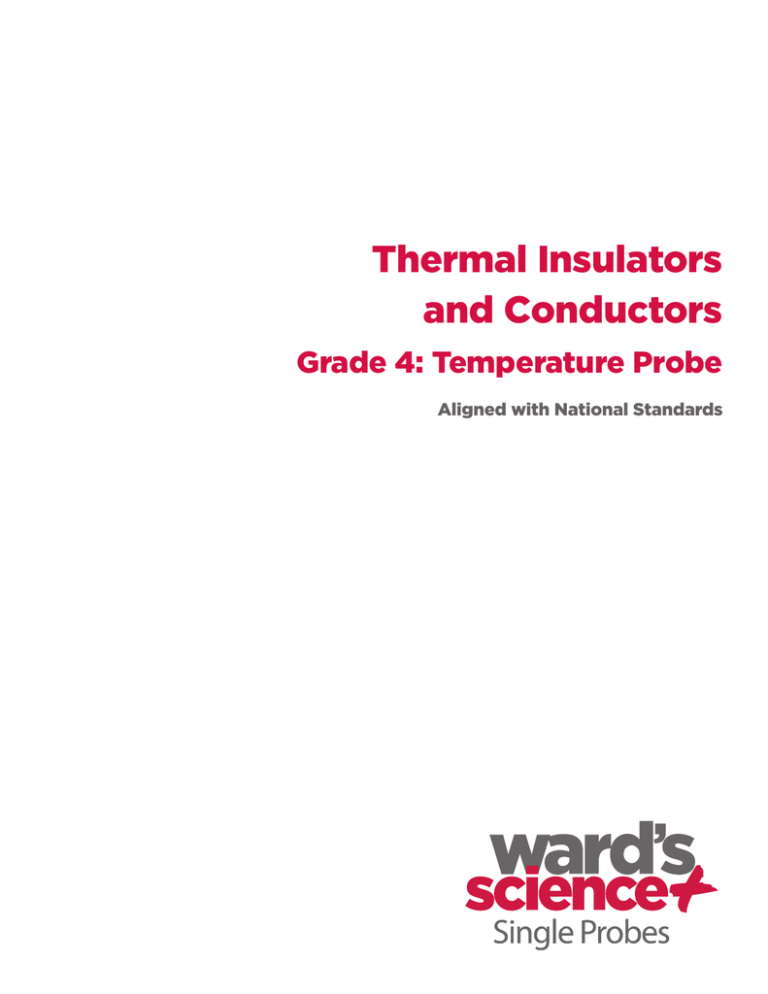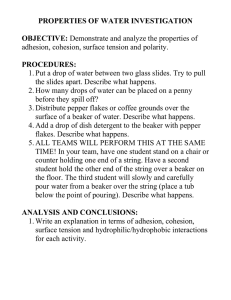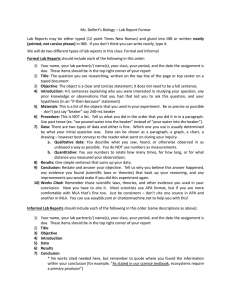
Thermal Insulators
and Conductors
Grade 4: Temperature Probe
Aligned with National Standards
overview
This is an activity where students demonstrate and observe the effects that different materials
have on the transfer of heat. Students will make observations to provide evidence that energy can
be transferred from place to place by heat.
This activity uses the WARD’s Single Temperature Probe to collect data, allowing students to focus
on the science discovery and leaving more time for learning and developing higher level thinking
skills. If you prefer, a simple thermometer can be used in this activity.
time requirement:
This activity can be completed in one session of 45 - 60 minutes.
materials required for the activity:
Beaker(s)
Temperature probe or thermometer
Aluminum foil
Water
Cardboard Heat source for water (i.e., microwave, hot plate, etc)
Styrofoam or sheet of craft foam
Timer/clock/stopwatch
Instructions - this guide and student prediction and data sheet (page 7)
safety precautions
general safety:
• Consider establishing a safety contract that students and their parents must read and sign. This
is a good opportunity to identify students with allergies (e.g., latex) so that you (and they) will
be reminded of specific lab materials that may pose risks to individuals.
• Remind students to read all instructions before starting the lab activities, and to ask questions
about safety and safe laboratory procedures. For the early grades that may not be proficient in
reading yet, review the safety and lab procedures together with your students.
• Students should take precautions around hot materials.
• Have students wash their hands after completing this and all lab activities.
Ward’s in-house scientists are always on call to assist you
with your questions. Our experts can provide personal
solutions and product advice for your curriculum.
Email sciencehelp@vwr.com
or call 800-962-2660 to get started.
Page 2
Call WARD’S at 1-800-962-2660 for Technical Assistance
standards alignment
Dimension 3
Core
Concepts
Dimension 2
Cross Cutting
Concepts
Dimension 1
Science and
Engineering
Practices
framework for K-12 science education © 2012
r
Asking questions (for science) and
defining problems (for engineering)
r
Use mathematics and computational
thinking
r
Developing and using models
r
Constructing explanations (for science) and
designing solutions (for engineering)
r
Planning and carrying out investigations
r
Engaging in argument from evidence
r
Analyzing and interpreting data
r
Obtaining, evaluating, and communicating
information
r
Patterns
Energy and matter:
Flows, cycles, and conservation
r
Cause and effect:
Mechanism and explanation
Structure and function
r
Scale, proportion, and quantity
Stability and change
Systems and system models
Discipline
Core Idea Focus
Physical Sciences
PS3.B: Conservation of Energy and Energy Transfer
NGSS
Standards
next generation science standards © 2013
Elementary School Standards Covered
4-PS3-2. Energy - Make observations to provide evidence that energy can be transferred from
place to place by heat
national science education standards © 1996
Content Standards (K-12)
Systems, order, and organization
r
Evidence, models, and explanation
r
Constancy, change, and measurement
Evolution and equilibrium
r
Form and Function
Physical Science Standards Elementary School
r
Light, Heat, Electricity, and Magnetism
r Indicates standards covered in activity
© 2014 WARD’S Science All Rights Reserved
Page 3
prior to class
• Determine the temperature of the classroom.
• Prepare and/or cut the test materials to wrap around the beaker(s).
• Review basic information about how to use and read a thermometer and/or the WARD’s Single
Temperature Probe.
objective
Students will understand that materials transfer heat.
background
Different materials transfer heat and keep things warm (or cool) in various ways. Some materials are
good thermal insulators, which do not let heat pass through easily. Thermal insulators are good at
keeping heat out and keeping heat in. A good example of a thermal insulator is your winter scarf
because it stops the heat from your body escaping into the cold air. Plastic is another good example
of a thermal insulator. It can be used as a handle on a saucepan - the plastic stops the heat from
traveling to your hand.
Other materials are good thermal conductors which do the opposite of insulators; they let heat pass
through them with ease. Metals are a good example of thermal conductors; we use metals to make
objects that need to conduct heat well. For example, metal pans conduct heat well so the food inside
heats up quickly.
Well-insulated buildings need less energy for heating than buildings that have no insulation. There
are two building materials that are being used more frequently worldwide: mineral wool and
polystyrene (styrofoam). Mineral wool is a good insulator because it holds air still in the matrix of the
wool so that heat is not lost. Since air is a poor conductor and a good insulator, this helps to keep
energy within the building. Polystyrene is also a good insulator and is able to keep cool things cool
and hot things hot. It has the added advantage of being resistant to moisture, mold and mildew.
Page 4
Call WARD’S at 1-800-962-2660 for Technical Assistance
lesson
build upon prior knowledge:
• Ask students if they had to pick up a hot object would it be safer to use a pot holder or a strong
steel gauntlet, like what a knight might wear. (Student response might include, the metal gauntlet
because it is stronger.)
Pot Holder
Knight’s metal gauntlet
(continued on next page)
© 2014 WARD’S Science All Rights Reserved
Page 5
lesson
procedure
1. Show students the 3 materials that will be wrapped around a
beaker of boiling water. Have students make and write predictions
about which material will hold the heat the longest. See next page
for a sample tally sheet.
guiding
questions
+What do you think will
happen? (Hypothesis)
+What do you expect to
learn?
+What tools are needed?
+How can we record our
findings?
2. Determine the temperature in the classroom and record. See next
page for a sample data sheet.
3. Bring a measured amount of water in a beaker to a boil.
4. Remove the beaker from the heat source and take the initial
temperature of the water and record. The thermometer should
stay in the beaker for the students to observe the change in
temperature as the water cools.
5. Have students note and record how long it takes for the boiling
water to reach room temperature without any material around the
beaker.
6. Bring the same amount of water to a boil again. When the beaker
is removed from the heat source, put aluminum foil around the
beaker and observe the temperature as the water cools to room
temperature. Record how long it takes.
7. Boil the water again. This time put Styrofoam around the beaker
when it is removed from the heat source. Observe the temperature
as the water cools to room temperature. Record how long it takes.
8. Boil the water again. This time put cardboard around the
beaker and observe the temperature as the water cools to room
temperature. Record how long it takes.
summarize
Ask students what they have learned about the effect the test
materials have on the release or retention of heat energy. (Student
responses may include: The Styrofoam holds in the heat the best.
Cardboard and the foil do not hold in heat as long.)
(continued on next page)
Page 6
Call WARD’S at 1-800-962-2660 for Technical Assistance
lesson
extension
Have students suggest other materials that may be thermal insulators
or conductors. Allow students to test their theories and record the
information to share with the rest of the class.
Sample Tally sheet
# of students who think this
beaker will take the longest to
reach room temperature
beaker with nothing on it
about how to use and read
a thermometer.
beaker with Styrofoam
+This activity uses the
beaker with cardboard
Initial Temperature of Boiling Water ____________
Room Temperature ___________
beaker with nothing on it
teacher
notes
+Review basic information
beaker with aluminum foil
Sample Data sheet
note
Time for temperature to return
to room temperature
Ward’s Single Probe to
collect data allowing
students to focus on the
science discovery, leaving
more time for learning and
developing higher level
thinking skills.
+The activity can be
done as a classroom
demonstration or
students can work in
small groups.
beaker with aluminum foil
beaker with Styrofoam
beaker with cardboard
© 2014 WARD’S Science All Rights Reserved
Page 7
5100 West Henrietta Rd • PO Box 92912 • Rochester, NY 14692-9012 • p: 800 962-2660 • f: 800 635-8439 • wardsci.com





